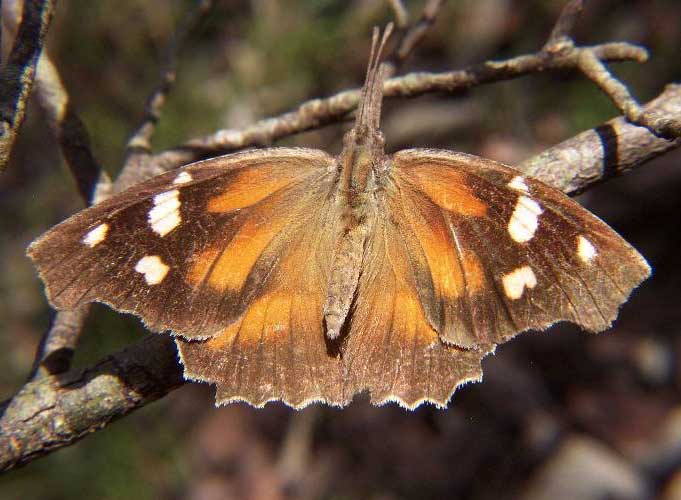
Libytheana carinenta (*)
Superregnum: Eukaryota
Cladus: Unikonta
Cladus: Opisthokonta
Cladus: Holozoa
Regnum: Animalia
Subregnum: Eumetazoa
Cladus: Bilateria
Cladus: Nephrozoa
Cladus: Protostomia
Cladus: Ecdysozoa
Cladus: Panarthropoda
Phylum: Arthropoda
Subphylum: Hexapoda
Classis: Insecta
Cladus: Dicondylia
Subclassis: Pterygota
Cladus: Metapterygota
Infraclassis: Neoptera
Cladus: Eumetabola
Cladus: Endopterygota
Superordo: Panorpida
Cladus: Amphiesmenoptera
Ordo: Lepidoptera
Subordo: Glossata
Cladus: Coelolepida
Cladus: Myoglossata
Cladus: Neolepidoptera
Infraordo: Heteroneura
Cladus: Eulepidoptera
Cladus: Ditrysia
Cladus: Apoditrysia
Cladus: Obtectomera
Superfamilia: Papilionoidea
Familia: Nymphalidae
Subfamilia: Libytheinae
Genus: Libytheana
Species: Libytheana carinenta
Subspecies: L. c. bachmanii – L. c. carinenta – L. c. larvata – L. c. streckeri
Name
Libytheana carinenta (Cramer, 1777)
Synonyms
Papilio carinenta Cramer, 1777

References
Kawahara, A.Y. 2013. Systematic revision and review of the extant and fossil snout butterflies (Lepidoptera: Nymphalidae: Libytheinae). Zootaxa 3631(1): 001–074. DOI: 10.11646/zootaxa.3631.1.1 Preview. Reference page.
The American snout or common snout butterfly (Libytheana carinenta) is a member of the subfamily Libytheinae in the brush-footed butterfly family, Nymphalidae. This species is found in both North and South America. The larval host plants are Celtis species on which the eggs are laid singly. Massive migrations of this species often attract attention in the Texas and Mexican newspapers.
Description
Snout butterflies have prominent elongated mouthparts (labial palpi) which, in concert with the antennae, give the appearance of the petiole (stem) of a dead leaf. Snouts often take advantage of this superb camouflage by hanging upside down under a twig, making them nearly invisible. Wings are patterned black-brown with white and orange markings. The forewings have a distinctive squared off, hook-like (falcate) tip.
Dorsal view
Side view
The caterpillars appear humpbacked, having a small head, swollen first and second abdominal segments, and a last abdominal segment which is tapered and rounded. They are dark green with yellow stripes along the top and sides of the body, and have two black tubercles on the top of the thorax. Their food is the common hackberry (Celtis occidentalis) tree.[3]
Migrations
This species is known to be migratory, and some years the migrations are so huge as to darken the sky in places. Migrations from South Texas northward occur at irregular intervals when southern populations explode,[4] often affecting San Antonio,[5] the Texas Hill Country,[6] and Austin.[7] Other migrations have been observed in Arizona, Kansas, and the Lake Erie Islands. Migrations occur from June through October, and are thought to be triggered by droughts followed by heavy summer rains: the droughts reduce a parasitoid that would otherwise limit butterfly populations, whereas the rains induce the spiny hackberry to grow new leaves which provide food for caterpillars.[8] Furthermore, whereas the droughts send the butterflies into a sort of hibernation, the rains bring them out of it all at once to lay eggs, causing a population explosion.[9] In Texas, years in which migrations were observed include 1921, 1978,[8] 1996,[4] 2018,[9] and 2020.[5]
References
"NatureServe Explorer 2.0 Libytheana carinenta American Snout". explorer.natureserve.org. Retrieved 29 September 2020.
Walker, A. (2020). "Libytheana carinenta". IUCN Red List of Threatened Species. 2020: e.T160608A842729. doi:10.2305/IUCN.UK.2020-3.RLTS.T160608A842729.en. Retrieved 18 November 2021.
American Snout, Butterflies of Canada
"Snout Butterfly". Field Guide to Common Texas Insects. Texas A&M AgriLife Extension. Retrieved 2020-10-02.
Kirkpatrick, Brian (2020-09-29). "The Butterflies Are Back: Snout-Nosed Insects Invade San Antonio Once Again". Texas Public Radio. Retrieved 2020-10-02.
Burgess, Cary (2020-09-28). "Butterfly invasion due to migration and strong cold front". Kerrville Daily Times. Retrieved 2020-10-02.
Perez, Pattrick (2020-10-01). "Seeing more butterflies? Here's why". KVUE. Retrieved 2020-10-02.
Quinn, Mike (2009-10-12). "Snout Butterfly". American Snout. Texas Entomology. Retrieved 2020-10-02.
Maeckle, Monika (2018-08-03). "Snout Butterfly". Snout-nosed butterfly population surges in South Texas following recent rains. Texas Butterfly Ranch. Retrieved 2020-10-02.
Retrieved from "http://en.wikipedia.org/"
All text is available under the terms of the GNU Free Documentation License

